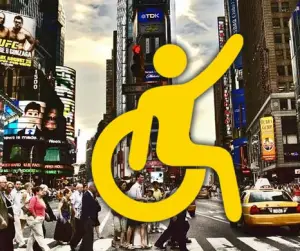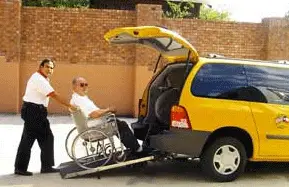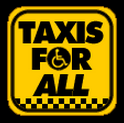A non-disabled person is over 25 times more likely to get a taxi within ten minutes than is a person who uses a wheelchair.
 If you are handicapped or disabled and find yourself in a wheelchair or with someone who is in a wheelchair, you understand the hassle and difficulty of finding a taxi. In most large cities in the United States, handicap-accessible taxis are sparse and not found regularly driving through the streets. For instance, in New York City, less than 2% of the 13,000 cabs are wheelchair accessible. Therefore, due to the scarcity, these cabs are nearly impossible for the disabled to hail on a whim to be transported quickly and easily. The higher price and lack of wheelchair-accessible taxis often leaves handicapped individuals feeling helpless, trapped and most of all, unequal. TaxiFareFinder has compiled a few tips and suggestions to assist those in need of wheelchair-accessible taxis and facilitate the process.
If you are handicapped or disabled and find yourself in a wheelchair or with someone who is in a wheelchair, you understand the hassle and difficulty of finding a taxi. In most large cities in the United States, handicap-accessible taxis are sparse and not found regularly driving through the streets. For instance, in New York City, less than 2% of the 13,000 cabs are wheelchair accessible. Therefore, due to the scarcity, these cabs are nearly impossible for the disabled to hail on a whim to be transported quickly and easily. The higher price and lack of wheelchair-accessible taxis often leaves handicapped individuals feeling helpless, trapped and most of all, unequal. TaxiFareFinder has compiled a few tips and suggestions to assist those in need of wheelchair-accessible taxis and facilitate the process.
Look up wheelchair accessible taxi fleets in your city of choice. Because it is rare to find a wheelchair accessible taxi on the street exactly when you need it, researching companies to know ahead of time is crucial. The majority of cities do have a fleet of wheelchair friendly taxis, so the challenge is just finding and locating the contact information. We looked up handicap accessible fleets in several major cities and many have websites accessible through the visitor page of the city website, stand-alone websites or can be found in the yellow pages. Additionally, while researching, it may be worthwhile to look into programs that offer discounts or specials. Many cities and fleets offer programs that provide discounted fares and other savings. Save the contact information for the taxi fleet on your cell phone or write it down on a pad of paper for easy access.
 Call to reserve a taxi for a specific time. Call to reserve a wheelchair accessible taxi ahead of time because there are generally a limited number in a fleet and one may not be immediately available. Try to call at least an hour before you need the taxi. As always, be very clear about your beginning location and end destination, giving specific street names when possible. Also, ask about arranging a ride home while on the phone, instead of waiting until the ride to your destination.
Call to reserve a taxi for a specific time. Call to reserve a wheelchair accessible taxi ahead of time because there are generally a limited number in a fleet and one may not be immediately available. Try to call at least an hour before you need the taxi. As always, be very clear about your beginning location and end destination, giving specific street names when possible. Also, ask about arranging a ride home while on the phone, instead of waiting until the ride to your destination.
Double-check straps and securing devices. Always ask the taxi driver or fellow passenger to ensure that the straps or other types of securing devices are properly fastened. It is important to take the time to check these devices; there have been too many news stories about accidents with handicap accessible taxis. For more information on securing devices and proper methods, look at this website.
Be prepared for the fare. Expect the final fare to be somewhat higher than a non-handicap accessible taxi. Most fares are found to be 5% more or higher, generally because they are larger, specialty vehicles. Finally, as with any taxi ride, be sure to tip 10-15% for good service.
Whether you are in a wheelchair short-term or long-term, we hope you find this article helpful. To join the movement to increase the amount of wheelchair-accessible taxis in New York City and other urban areas, visit the Taxis For All Campaign website.

